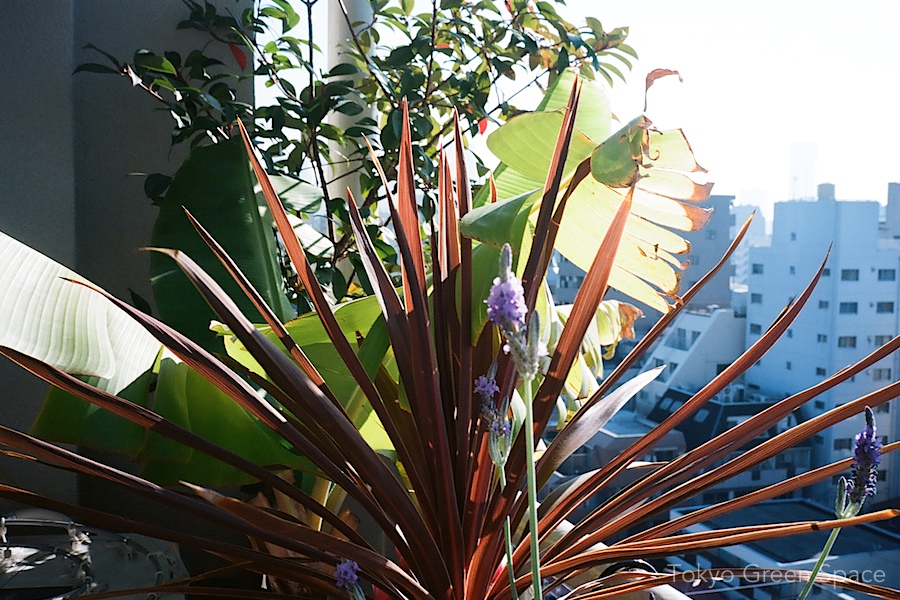
ベランダにあるこの四つの植物はそれぞれに別の色や形や起源があります。起源は、フランス、オーストラリア、フィリピン、東京です。
This balcony vignette includes contrasting colors and shapes with plants from France, Australia, Pilipinas, and Tokyo (lavender, formium, banana, and kanamemochi).

小さな植木鉢の草がもっと詳しく見えます。色と動きがあって、大好きです。
The color and movement of this grass growing in a small flowerpot are very enjoyable.

6月の梅雨で、一番きれいな花はアジサイでしょうか。色と種類が多いですが、僕は全部、大好きです。最近、伊豆の小さな田んぼのよこで、アジサイが咲いていたのを見ました。
I love all types of hydrangea. They are always so oversized, and particularly well suited to Japan’s rainy season. I like the elegant ones that bloom more sparingly, and also the giant pom pom types that come in so many different shades. Recently we saw hydrangea planted on the border of small rice fields in Izu.


In mid-summer, the morning glory provides color, shade, and privacy on my one meter wide (3 feet) apartment balcony. The smaller jasmine leaves provide a nice contrast. Also on my green curtain are Edo morning glory (vs the Okinawa one above) and cucumber.
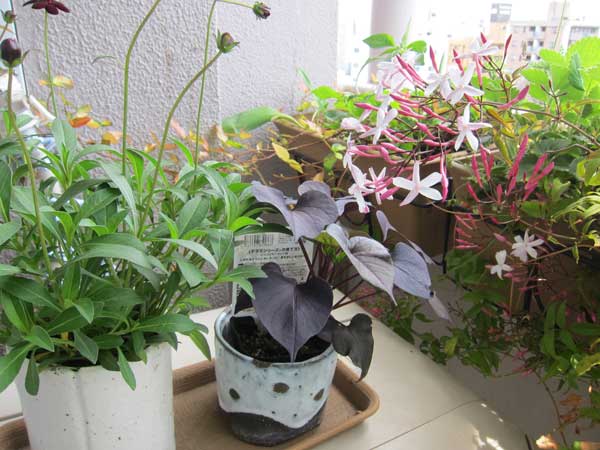



3.11の一年目の追悼と反原発のヒューマンチェーンに参加して、写真をたくさんとりました。高齢者が多くて、コズプレもあって、悲しく、同時に色がたくさんありました。ポケモンを何人か見ました。数万人が国会議事堂を囲んで、非常に感動しました。
On the first anniversary of the March 11, 2011 earthquake, tsunami and nuclear disasters, I spent the afternoon at a memorial in Hibiya Park, and then joined tens of thousands forming a human chain around Japan’s national assembly, the Diet. I snapped a lot of photos, along with @sub_fauna, who took some great photos.
It was great to see so many people coming together to ask for fundamental change to energy and politics. Striking were the number of seniors, the odd costumes including several Pokemon, the mix of the mournful and colorful. A few Japanese friends asked me what a “human chain” was, as if it were a complicated imported notion. It was very touching to see people holding hands around the center of government.
I was also impressed with how organized the entire demonstration and policing were. The long cross-walk in front of the Diet was occupied only while the light was red. The police remained very calm, and their main tools were rolls of neon police tape, megaphones, and fabric traffic barriers with rings for lines of police to easily hold.

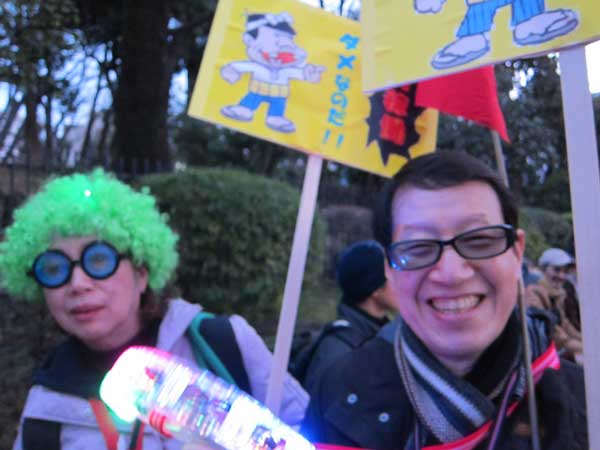



This lovely lilac flower with an odd name, Scabiosa blue balloon, is one I don’t remember seeing before. It’s native to southeast England, and developed into a garden cultivar. I like to mix up nostalgic plants like daffodils with ones I’m not familiar with.
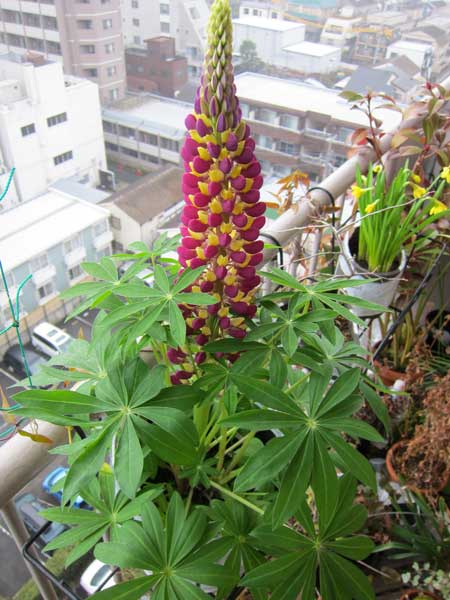
この冬は長くて寒いですね。最近、自転車でホーム・センターに行って、花をたくさん買いました。ルピナスと言う花はキャンディーのような色です。北米の起原だけど、日本のは全然違います。ベランダに置きました。素敵です。
This winter seems to never end. So I biked over to the local home center recently, and loaded up on bright flowers including daffodils, tulips, stock, and this amazing lupinus. I am familiar with it as a very handsome deep blue flowering perennial, native to North America, that becomes a bush. I’d never seen it in candy colors and bred for maximum floral display. It’s at once familiar, odd, and just the right antidote for more cold days.
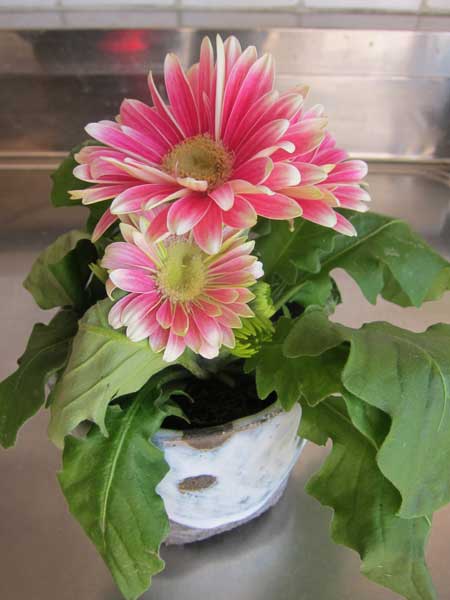
もう一つ、植物の室内撮影。このミニガーベラはとても派手ですね。たくさん化学肥料を使っているからかもしれません。ホームセンターにはそんな植物が多いです。短い茎は異常で、このピンクと白色のガーベラは人工的です。人工的に育てられた花と手作りの陶芸を組み合わせるのはかっこいいと思います。
More indoor plant portrait photography.
I love how this short stemmed pink-and-white gerber is so loud. It seems super-charged with fertilizers, which seems likely since I bought it at Shimachu, a “DIY” home center in Nakano. I like the prices and the proximity, although I consider many of their plants more on the human side of the nature continuum.
In winter, it seems like some of the filler and seasonal color I bought there is lasting a long time. And I think there’s a perverse balance in combining factory-produced plants with hand-made ceramic.
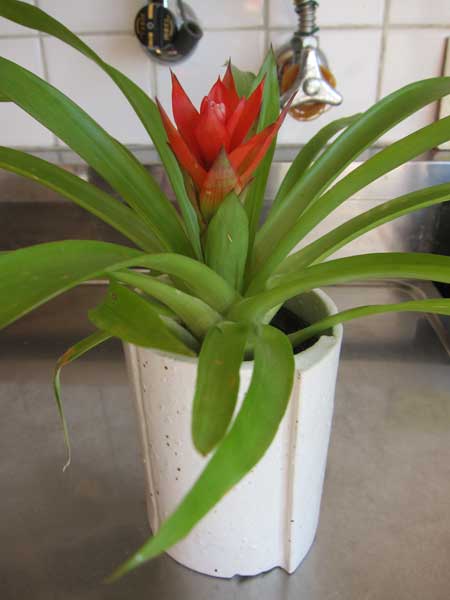
More indoor plant portrait photography.
I like bromeliads, which brings color indoors easily. This one still looks good after I bought it in November. They are especially lovely in winter. The white ceramic I made at Shiho ceramic studio.

この停留所は東京グリーンスペースの比喩です。昔、公共スペースは計画されたことがありません。今は都市の指導者と官僚が車中心社会とメガ開発を支えすぎます。3.11の前、政府が悪くても、東京はいい都市だと思いました。3.11の後、無能な指導者は危ないと思います。
年末が近づくにしたがって、もっと生きている都市をどう作れるかと考えています。
This sidewalk and street have nearly no visible plants. Yet anonymously gifted bus stop chairs are very Tokyo and very much in the spirit of Tokyo green space. Reacting to a lack of infrastructure– no shelter and no seating– neighbors simply recycle and re-use stuff from their homes and share it with neighbors in a public space.
Few designers could have coordinated this unlikely mix of colors, fabrics, and shapes. Its aesthetic arises from its spontaneous appearances. Is this the most beautiful, practical, or ideal solution to the lack of infrastructure? Probably not, although it reflects generosity and concern for others in shared spaces.
I have been writing about Tokyo green space for a while, ever since moving here three years ago. Tokyo is surprisingly green and livable despite the complete absence of planning for public open space, from its rise as Japan’s Edo capitol in the 1600s through the 20th century’s natural and man-made calamities that twice obliterated the city.
Tokyo has such forward-looking urban features like walkable small streets dominated by pedestrians and bicyclists. But these vital paths exist not because of contemporary Tokyo’s good planning, but because the bureaucracy still in the thrall of automobile infrastructure and mega-developments hasn’t had the chance to alter them.
Documenting Tokyo green space has been a way for me to understand the life of this city. The grass-roots reclaiming of public space certainly increases the city’s appeal. But, post 3.11, I also now wonder if the residents haven’t demanded enough of the city leaders. We now know more clearly the dangers of leaving vital decisions to reckless and outdated politicians and bureaucrats.
As this difficult year ends, I wonder what all of us can do to create a more alive city.